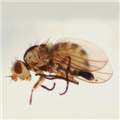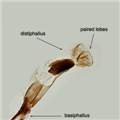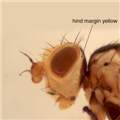Nomenclature
Liriomyza cicerina (Rondani 1875)
Agromyza cicerina Rondani 1875Liriomyza ononidis de Meijere 1925 Liriomyza trichophthalma Hendel 1931Common name: chickpea leafminer
Hosts
Liriomyza cicerina has only been recorded from Fabaceae: Cicer arietinum (chickpea), Hymenocarpus circinnatus (disk trefoil), Melilotus alba (white sweetclover), M. officinalis (yellow sweetclover), Ononis species, including O. arvensis (field restharrow), O. repens (common restharrow), O. spinosa (spiny restharrow). Liriomyza cicerina occurs commonly on Ononis species in Western Europe and it seems probable that this is the primary host, from which it colonised Cicer arietinum when this plant was introduced into Southern Europe from India in classical times (Dempewolf 2004; Spencer 1973, 1990).
Distribution
Africa: Algeria, Egypt, Libya, Morocco, Tunisia Asia: Afghanistan, India, Iran, Iraq, Jordan, Kazakhstan, Lebanon, Syria, Turkey, Turkmenistan, UzbekistanEurope: Albania, Azerbaijan, Bulgaria, Denmark, England, Estonia, Germany, Italy, Portugal, Romania, Slovakia, Spain, Sweden, Ukraine, Yugoslavia
Based on data from Koles�k & Pastucha (1992), Martinez (2007), Naresh & Malik (1989) and Crop Protection Compendium (2007).
Key characters
Head with vertex dark, at least outer vertical bristles on black ground, third antennal segment round and variably dark to almost entirely dark, first and second segments yellowish, mesonotum shiny black, scutellum yellow, femora basically yellow with some brownish striations. Wing length 1.3-1.6 mm. Wing with last section of CuA1 3 times length of penultimate section. Aedeagus: distiphallus with two distal bulbs, bulb rims circular, subapical part of distiphallus with long, narrow and strongly sclerotised area. Larva with posterior spiracles each with an ellipse of 7 to 9 pores. See PaDIL diagnostic images (Malipatil 2007).
Notes
Liriomyza cicerina is an important pest of chickpea in West Asia, North Africa and Southern Europe, with yield losses up to 30% having been recorded (Singh & Weigand 1994). Infestation of the plants is often severe and can strongly affect the vitality of the plants and reduce the amount and quality of the yield (�ikman & Civelek 2007). Heavily infested leaves become yellow and senesce prematurely (Koles�k & Pastucha 1992).
Weigand & Tahhan (1990) noted that in Syria, the first leafminer generation emerged from diapause in late March and the second generation reached peak numbers in mid May. When the host chickpea plants mature the leafminers disappear and it is suspected that they survive the summer and winter as pupae in diapause.
A number of sources of resistance to L. cicerina have been found in germplasm collections (Singh & Weigand 1994; Malhotra et al. 2007) and the use of resistant cultivars would be of great value to farmers. The two dominant species of parasitoids in Syria, among a complex of species, are Diglyphus isaea (Walker) (Eulophidae) and Opius monilicornis Fischer (Braconidae) (Weigand & Tahhan 1990). While L. cicerina can be effectively controlled by broad-spectrum insecticides, their use greatly reduces the number of parasitoids (El Bouhssini et al. 2004; El Bouhssini et al 2008). Natural enemies of chickpea leafminer need to be conserved as they play a major role in regulating the insect population.
In southern Australia, common agromyzids such as L. chenopodii, L. brassicae and Chromatomyia syngenesiae (usually on Sonchus oleraceus) on weeds and other non-crop plants would act as important reservoirs for populations of parasitoids of L. cicerina and other invasive polyphagous agromyzids (Bjorksten et al. 2005; Lardner 1991). However, in the dryland cropping areas of Australia, the existing parasitoid complex would also need to enter into summer diapause or aestivation in order to oversummer successfully because the weed reservoirs would not be present in these areas in summer. In Japan, Chrysocharis pubicornis (Zetterstedt), a eulophid parasitoid attacking Chromatomyia horticola, has been shown to diapause in summer (Baeza Larios & Ohno 2007; Baeza Larios et al. 2007). This species is present in Australia but further research is needed in Australia to establish whether key parasitoids, such as Diglyphus isaea, exhibit a facultative summer diapause.
Further information and images are given in the PaDIL fact sheet (Malipatil 2007). together with images of Liriomyza cicerina and damage it causes to chickpea (Turkey).
References
Baeza Larios GL & Ohno K (2007). Larval summer diapause of Chrysocharis pubicornis (Zetterstedt) (Hymenoptera: Eulophidae), a pupal parasitoid of agromyzid leafminers: Sensitive stage for diapause induction and effects of cool exposure on diapause termination. Applied Entomology and Zoology 42: 587-594.
Baeza Larios GL, Ohno K & Fukuhara F (2007). Effects of photoperiod and temperature on preimaginal development and summer diapause of Chrysocharis pubicornis (Zetterstedt) (Hymenoptera: Eulophidae), a pupal parasitoid of leafminers (Diptera: Agromyzidae). Applied Entomology and Zoology 42: 189-197.
Bjorksten TA, Robinson M & La Salle J (2005). Species composition and population dynamics of leafmining flies and their parasitoids in Victoria. Australian Journal of Entomology 44: 186-191.
Crop Protection Compendium (2007). 2007 Edition � CAB International, Wallingford, UK.
�ikman E & Civelek HS (2007). Does Liriomyza cicerina affect the yield of chickpeas (Cicer arietinum)? Phytoparasitica 35:116-118.
Dempewolf M (2004). Arthropods of Economic Importance - Agromyzidae of the World (CD-ROM). ETI. University of Amsterdam, Amsterdam. https://agromyzidae.linnaeus.naturalis.nl/linnaeus_ng/app/views/species/nsr_taxon.php?id=57042&epi=55
El Bouhssini M, Malhotra RS, Babi A & Mardini K (2000). Sprays that spare pest predators. Caravan 12: 15
El Bouhssini M, Mardini K, Malhotra RS, Joubia A & Kagkac A (2008). Effects of planting date, varieties and insecticides on chickpea leaf miner (Liriomyza cicerina R.) infestation and the parasitoid Opius monilicornis F. Crop Protection 27: 915-919.
Hendel F (1931-1936). 59. Agromyzidae. In Die Fliegen der pal�arktischen Region (ed. Lindner E). Schweizerbart'sche Verlagsbuchhandlung, Stuttgart: VI 2: 12 + 570 pp., Taf. I-XVI.
Koles�k P & Pastucha L (1992). Chickpea leafminer Liriomyza cicerina (Rondani, 1875) [Diptera, Agromyzidae] - a new species of Czecho-Slovak fauna. Biol�gia (Bratislava) 47: 439-440.
Lardner RM (1991). Comparative host stage utilization of two parasitoids of Liriomyza brassicae (Diptera: Agromyzidae). PhD Thesis, University of Adelaide. thesis details,
Malhotra RS, Bouhssini ME & Joubi A (2007). Registration of seven improved chickpea breeding lines resistant to leaf miner. Journal of Plant Registrations 1: 145-146.
Malipatil MB (2007). Chickpea leafminer (Liriomyza cicerina) Pest and Diseases Image Library. Updated on 11/07/2007. http://www.padil.gov.au
Martinez M (2007). Fauna Europaea: Agromyzidae. In Pape T (ed.) (2007) Fauna Europaea: Diptera: Brachycera. Fauna Europaea version 1.3 [128093] http://www.fauna-eu.org
Meijere JCH de (1925). Die Larven der Agromyzinen. Tijdschrift voor Entomologie 68: 195-293.
Naresh JS & Malik VS (1989). Observations on the insect pests of chickpea (Cicer arietinum L.) in Haryana. Bulletin of Entomology New Delhi 27 (1986): 75-77.
Rondani C (1875). Species italicae ordinis Dipterorum (Muscaria, Rndn.). Bollettino della Societ Entomologica Italiana 7: 166-191.
Singh KB & Weigand S (1994). Identification of resistant sources in Cicer species to Liriomyza cicerina. Genetic Resources and Crop Evolution 41: 75-79.
Spencer KA (1973). Agromyzidae (Diptera) of economic importance. Series Entomologica 9. Dr W Junk, The Hague. 418 pp.
Spencer KA (1990). Host specialization in the world Agromyzidae (Diptera). Series Entomologica 45. Kluwer Academic Publishers, Dordrecht. 444 pp.
Weigand S & Tahhan O (1990). Chickpea insect pests in the Mediterranean zones and new approaches to their management. In Chickpea in the nineties. (eds van Rheenen HA & Saxena C) ICRISAT, Patancheru, A.P. 502 324, India, pp. 169-175.
WWW Resources
Liriomyza cicerina in Dempewolf M (2004). Arthropods of Economic Importance - Agromyzidae of the World
PaDIL diagnostic images. Chickpea leafminer Liriomyza cicerina (Rondani) (Diptera: Agromyzidae). Pest and Diseases Image Library. Updated on 11.vii.2007. http://www.padil.gov.au/pests-and-diseases/pest/main/136238
Liriomyza cicerina in Ellis WN (2018). Plant Parasites of Europe - leafminers, galls and fungi
Liriomyza cicerina in Pitkin B, Ellis W, Plant C & Edmunds (2008). The leaf and stem mines of British flies and other insects
Liriomyza cicerina in Martinez M (2007). Fauna Europaea: Agromyzidae. In Pape T (ed.) (2007) Fauna Europaea: Diptera: Brachycera. Fauna Europaea version 1.3 [128093]























